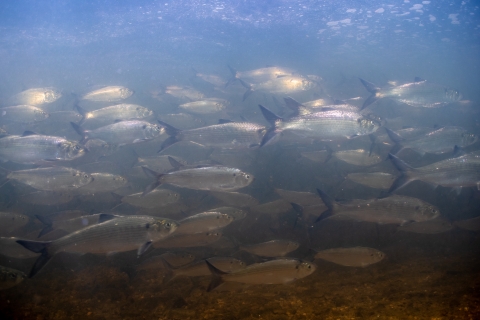The marathon of migration is a wildlife event like no other. The journey that wildlife undergo in search of food, habitats, and mates can span countries, continents, and even oceans. During the spring, we can observe migration marvels as they unfold around us. You may hear them in the summer songs of migratory birds outside your window or see them in the colorful flash of the orange and black monarch butterfly returning to your garden.
Each year, fish undergo the same difficult migratory routes, but their journeys can be much harder to observe. Fortunately, there are ways to see fish up close and witness migration in action!
At national fish hatcheries, Service staff work to support wild fish and other aquatic animal populations, and many offer the opportunity to see the species up close. Each year, fish biologists and partners raise several species of migratory fish for release back into the wild. Find a national fish hatchery providing fish viewing opportunities near you!
From the river to the sea
Atlantic salmon is the focus at Green Lake National Fish Hatchery in the Gulf of Maine. This hatchery works with state, federal, and Tribal partners to reestablish these endangered fish populations in the Gulf of Maine rivers. In fact, three out of every four Atlantic salmon returning to United States waters come from Green Lake National Fish Hatchery and you can see them at accessible view pools outside of the facility!
Nashua National Fish Hatchery in New Hampshire is one of the oldest hatcheries still in operation in the United States. Dedicated to supporting migratory fish like American shad and alewife, the hatchery encourages the public to visit the fish viewing areas to learn more about the annual cycle of migratory fish and how the Service works to protect them. Depending on your visit, you may be able to see American shad eggs, fry, and brood stock. Just down the road from Nashua National Fish Hatchery, observe fish released into the Merrimack River at the Amoskeag Fish Ladder and Visitor Center in the underwater viewing window!
Founding fishways
While fish are on the move upstream to reach important spawning habitat, their migratory paths can be nothing short of an obstacle course. In the United States, there are over 6-million man-made barriers, like dams, that keep fish from getting to where they need to go to grow and survive.
Thankfully, structures called fishways have opened hundreds of river miles to migratory fish with the added benefit of allowing us to view the fish as they pass through.
In Holyoke, Massachusetts, species like America shad, river herring, and sea lamprey get a boost over the Holyoke Dam in an elevator designed just for fish. The public are welcome to tour the Robert E. Barrett Fishway with viewing windows into their underwater world. The Holyoke fishway also lets biologist count the fish as they navigate the Connecticut River, providing valuable insight into fish health. This World Fish Migration Day, join Service staff at the Holyoke fishway for an event and learn about fish restoration of the past, present, and future.
Migration in action
Fishways can be found all over the Northeast and are designed to help a variety of different migratory species. Virtually tour the fish ladder at the Vernon Dam in Vermont to learn how migratory sea lamprey return to the river or monitor the migration at the Turners Falls Fishway and the Northfield Mountain Fishway in Massachusetts. Whether fish ladder, elevator, or weir, all fishways help migratory fish return to our rivers each year.
Can’t make it in person? Catch the action live through wildlife cameras! There’s a plethora of virtual opportunities to see fish migrations happening across the country:





